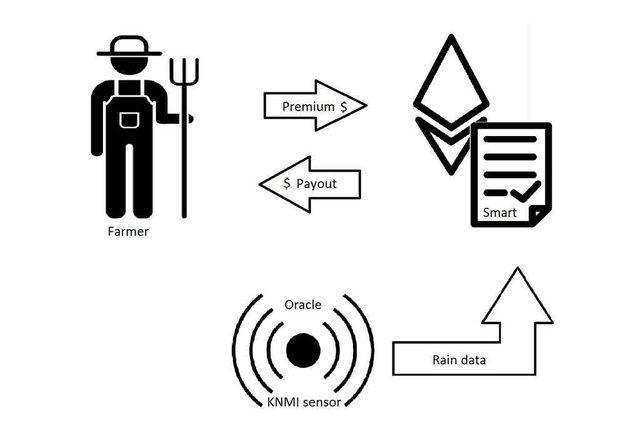
The spectacular increase in value that Ethereum has suffered causes a special interest in cryptocurrencies. In this year 2017, ETH has gone from being worth a few euros to reaching levels of around 300 euros per unit. Even the most cautious investor is considering investing.
But Ethereum is not just a currency to speculate like the shares of the stock market, at least we want to think some developers who are excited about what is to come.
The cryptocurrencies were not created to speculate with them, even this eagerness to make money at their expense harms its main task: to create a distributed system, where we do not need a centralized entity (see banks) to carry out operations. That responsibility falls on a distributed blockchain of thousands of nodes around the world that give us the same security or more. For now, speculation is used to finance part of the Open Source project that supports Ethereum and the ecosystem behind it.
The possibility of creating intelligent contracts linked to these transactions shows the tremendous potential of a platform that will not only revolutionize finances but also the internet.
Ethereum wants to make the blockchain more than a calculator
THE POSSIBILITY OF CREATING INTELLIGENT CONTRACTS (SMART CONTRACTS) LINKED TO TRANSFERS IS THE GREAT REVOLUTION THAT WAITS FOR THE FINANCIAL SECTOR.
Ethereum is much more than a cryptocurrency. In fact, when we refer to Ethereum we can be talking about the protocol or network of nodes that supports the system. And the best known part for non-programmers is the Ether currency, the cryptocurrency of Ethereum.
The first thing Ethereum does is to decentralize the control of transaction verification. Briefly describing how he does it, we can say that the responsibility falls on a blockchain that acts as an immense distributed database secure and maintained by a large number of nodes connected throughout the world (the miners).
The data is stored in blocks, which are linked to each other identified by a hash generated next to a timestamp. All that information is immutable, that is, nobody can modify it. And even more is replicated throughout all the nodes that form the network.
So far everything is very similar to what we find when we talk about Bitcoin. But Vitalik Buterin, inventor of Ethereum, already started designing in his white paper on Ethereum 2014 what would go a step further to be a simple calculator or a large account book.
The key component is this idea of a Turing-complete blockchain. ... As a data structure, it works kind of the same way that Bitcoin works, except the difference in Ethereum is, it has this built-in programming language.
SMART CONTRACT ARE IDEAL TO PERFORM MICRO-TRANSACTIONS GUIDED BY EVENTS VERIFIABLE BY THE NETWORK.
As we have mentioned, Ethereum allows developers to create small intelligent contracts in the blockchain. Such pieces of code are self-contained and define the agreements between multiple parties. We can make micropayments instantly if the conditions for which the agreement was created are met.
The great advantage is that they are immutable (they can not be modified while being in the blockchain), they do not need direct intervention but can mediate and make the monetary transfers automatically.
Smart contracts can be used in a wide variety of scenarios. They are ideal for simple transactions, in whose parts they should be bound to a set of verifiable requirements by the network, both within the blockchain and external variables through APIs.
We can think of different existing financial products that take days to be updated to be settled as funds, derivatives, futures, purchase options, etc .., but also any microtransaction that we now perform on a daily basis.
For example, we can develop a smart contract that manages the copyright of the fund of an image bank, every time a medium uses one of the images for some of its news, a micropayment of the ESHs will be made.
Or in another practical use create a microinsurance that assures farmers against drought by making payments associated with the data collected from rains in a period of time.

In Ethereum, smart contracts are programmed in Solidity, a language specifically created for this purpose. Let's say it's a hodgepodge of some conventions already used by web programmers and network applications. The syntax of the code is similar to JavaScript and C.
It allows to compile said contracts in the bytecode used by Ethereum that will be displayed in the virtual machines that represents the combination of nodes. That is, Ethereum Virtual Machine (EVM), responsible for executing that code, small 256-bit distributed computers.
These smart contracts can be programmed locally and then deployed to be spread around the entire network being hosted in a decentralized manner. In that sense, Ethereum combines the facets of networking, app hosting and database to store statements of such contracts.
Deploying applications in Ethereum is not a trivial task, since it has a certain learning curve. For this there are tools such as the browser Mist Browser that allows prototyping the scripts of smart contracts, create wallets and provides some functionality by command line to communicate with the Ethereum network.
Vitalik Buterin, inventor of Ethereum
Este post ha sido votado por @lince.
Te sugerimos leer la siguiente publicación para evitar publicar contenido clasificado como plagio o abuso en el futuro: Plagio textual, parcial o total de contenido ajeno.
No tiene nada de malo apoyarse de contenido de internet, solo procura citar la fuente de donde se obtuvo la información, que en este caso se encuentra Aquí.
https://www.xataka.com/empresas-y-economia/por-que-los-programadores-amamos-ethereum
Esto no es una bandera, es una recomendación para que leas el post de @lince y en el futuro evites cometer algún tipo de abuso.
Steemit es una plataforma en la que se recompensa el trabajo original y propio. Si existe alguna duda sobre cómo puedes evitar el plagio y abuso favor de leer las publicaciones informativas de @lince.
Para cualquier aclaración los medios de comunicación son por correo a [email protected] o en los chats de discord y steemit.chat
Downvoting a post can decrease pending rewards and make it less visible. Common reasons:
Submit
This post has been ranked within the top 25 most undervalued posts in the second half of Nov 02. We estimate that this post is undervalued by $18.32 as compared to a scenario in which every voter had an equal say.
See the full rankings and details in The Daily Tribune: Nov 02 - Part II. You can also read about some of our methodology, data analysis and technical details in our initial post.
If you are the author and would prefer not to receive these comments, simply reply "Stop" to this comment.
Downvoting a post can decrease pending rewards and make it less visible. Common reasons:
Submit
Hola Veronica, te hago una observación: si el primer tag (etiqueta) es "spanish", el contenido del post debe ser en español. Y veo que está todo en ingles...
También veo ahora que estás usando todas las etiquetas incorrectas, usas "spanish" (y no está en español), usas "photografy" y no hay fotografías.
¿Eres un bot que usa cualquier etiqueta popular? 0_o
Downvoting a post can decrease pending rewards and make it less visible. Common reasons:
Submit
No soy un bot solo que siempre lo ponia en español y no genero nada y puse en ingles y algo mas genere
Downvoting a post can decrease pending rewards and make it less visible. Common reasons:
Submit
Este Post ha recibido un Upvote desde la cuenta del King: @dineroconopcion, El cual es un Grupo de Soporte mantenido por 5 personas mas que quieren ayudarte a llegar hacer un Top Autor En Steemit sin tener que invertir en Steem Power. Te Gustaria Ser Parte De Este Projecto?
This Post has been Upvote from the King's Account: @dineroconopcion, It's a Support Group by 5 other people that want to help you be a Top Steemit Author without having to invest into Steem Power. Would You Like To Be Part of this Project?
Downvoting a post can decrease pending rewards and make it less visible. Common reasons:
Submit